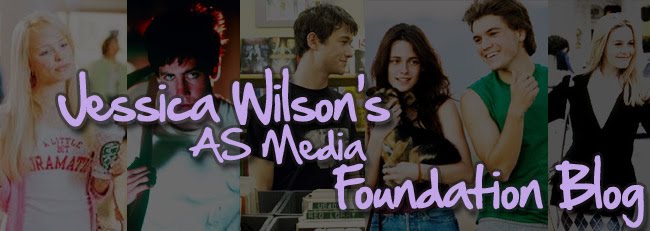10 Things I Hate About You (1999)
1. What is the genre of the film? How are the genre signifiers introduced?
This film is a High School Romantic Comedy. We can tell this by the cheery pop music used with the colourful titles at the very beginning of the film. The first characters we see are a group of teenage girls looking over-the-top happy and dancing in their open-top car, which we would expect to see in a romcom aimed at teenagers. The soundtrack then changes to a rock song, Bad Reputation, which clearly fits with the rebellious teenage girl we are introduced to next. All the girls are quite stereotypical - the cheery, girly girls and the lone, miserable-looking rebel - which fits with the conventions of this kind of film, and the way the girls look at each other in quite a bitchy way suggests that this film is a lot to do with cliques and social statuses, another key genre signifier. The next scene clearly shows a high school, and a boy shows a new student around the school whilst talking him through all the different cliques at the school, which is very stereotypical of this genre. There is also of course the classic 'love at first sight' moment with Joseph Gordon-Levitt's new student character and the typical blonde queen bee of the school.
2. Who are the main characters and how are they opposed?
There are a few main characters in this film: Kat, Patrick, Bianca and Cameron. Bianca is the pretty, popular good-girl, Kat is her rebellious older sister, Cameron is the new boy and Patrick is the mysterious 'bad-boy'. The first binary opposite we see (1:06 mins) is the group of girly, perfectly groomed, dancing girls listening to pop music in their car, in contrast to Kat pulling up in her car, on her own, listening to loud rock music ('I Don't give a damn about my reputation...') dressed in dark clothing and looking pretty miserable. The way the camera slowly pans across the screen from the girls in the first car to Kat really emphasises the contrast between them. The next binary opposite (2:42 mins) is between Cameron and Patrick. Cameron has just been shown as quite a nervous, stammery, innocent character, and when he rushes to leave the school office he comes face to face with Patrick, who is much taller and bigger-built than him. Patrick stares at him, looking tough, whereas Cameron is jittery, looks quite startled by him, and nods at him nervously before stumbling out. We are then shown a lot of binary opposites between all the different cliques around the school. There is another strong contrast (5:41 mins) between Kat and the rest of her fellow pupils in her class, shown when she voices her strong opinions that no-one else seems to agree with, especially when one girl describes Hemingway as 'so romantic' and Kat argues back that he was actually 'an abusive, alcoholic misogynist'.
3.What are the main themes of the film and how are they introduced?
One of the main themes will most likely be Cameron's attempt to get Bianca to go out with him, as we can guess by the way he seems to be enchanted by her as soon as he sees her that he won't just forget about her and not bother, despite being told that she is way out of his league and that she can't date anyway. This will of course involve one of the main themes of Romance, and probably Comedy too. There is also the theme of Rebellion, and Non-comformity, as we can tell that Kat is very outspoken with strong opinions, and the viewers will want to know whether she will stay like that throughout the film or maybe change her ways. We also wonder how Patrick will come into it, as he is introduced as a main character but he hasn't really had any connection with any of the other characters yet, although because he seems like such a strong character, we want to know more about him and what will happen to do with him and the other characters. The audience will probably guess that Kat and Patrick will have some kind of romance, as they are both shown as rebellious, non-comforming characters.
4. How is the narrative organised to show conflict?
The narrative deliberately flows straight from the girly-girls in their car to Kat in her car to show the difference between them, and these differences, plus the way they look at each other in an unfriendly way and Kat's outspoken attitudes, suggests that there will be a conflict between Kat and some of the other girls in her school, even if it's not necessarily these particular girls. The sudden switch of the music also shows conflict between their opinions and tastes. We already see conflict between Kat and her teacher, as well as Kat and Joey (a boy in her class) when she argues with them about literature.
Tuesday, 5 October 2010
Research: Levi-Strauss's Theory of Binary Opposites (10 Things I Hate About You)
Subscribe to:
Post Comments (Atom)


0 comments:
Post a Comment